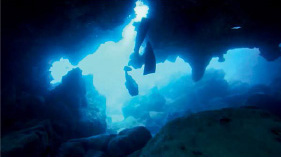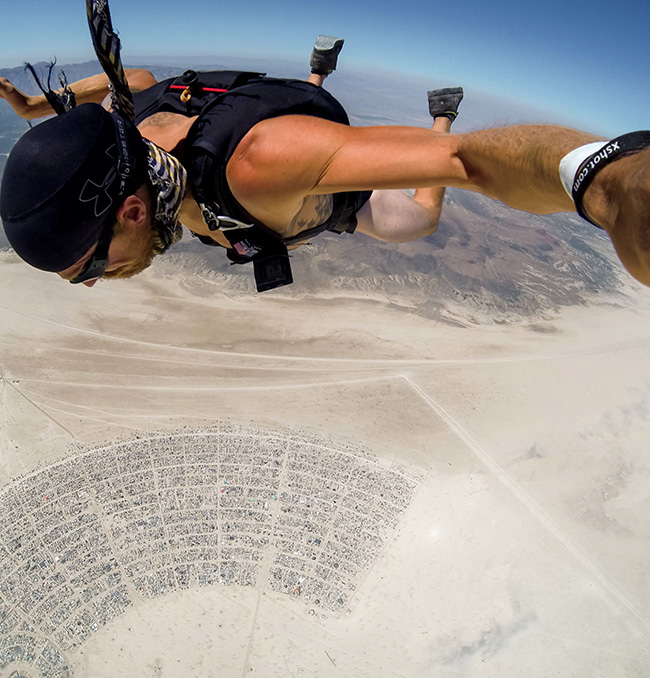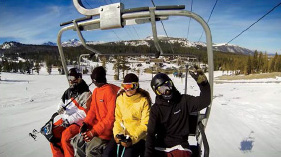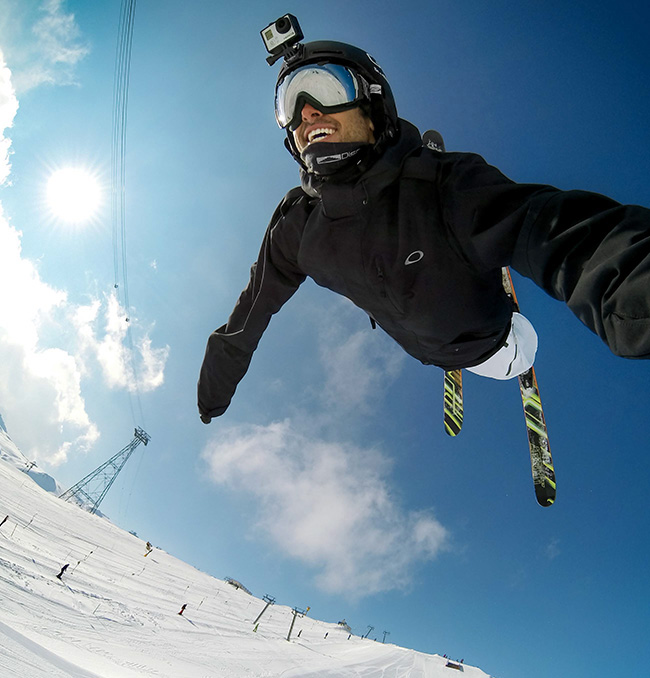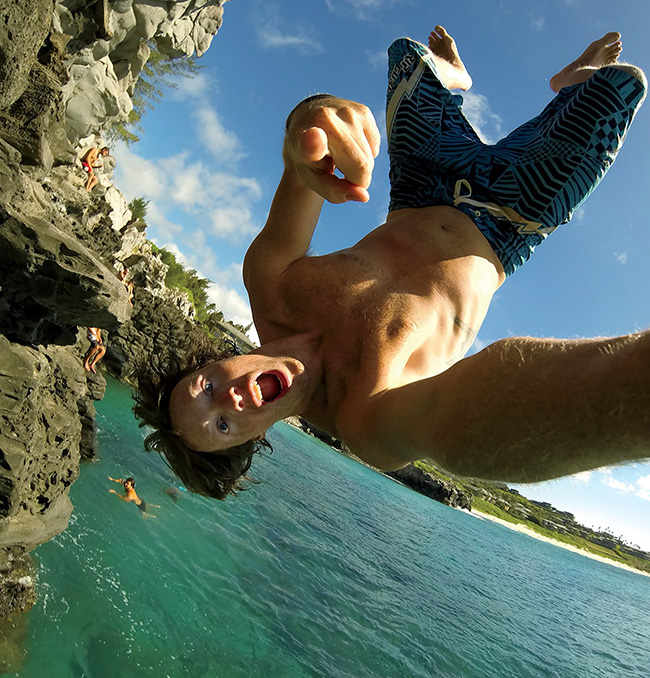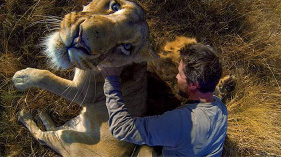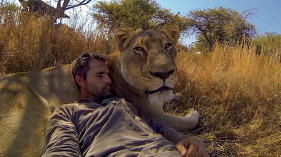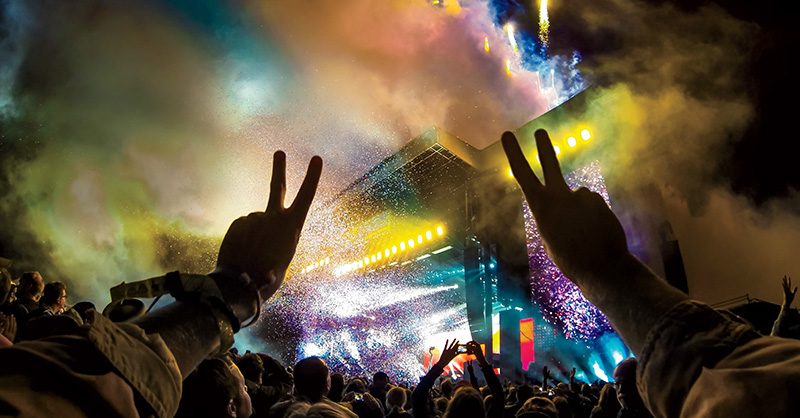Chapter 7. Share Your World
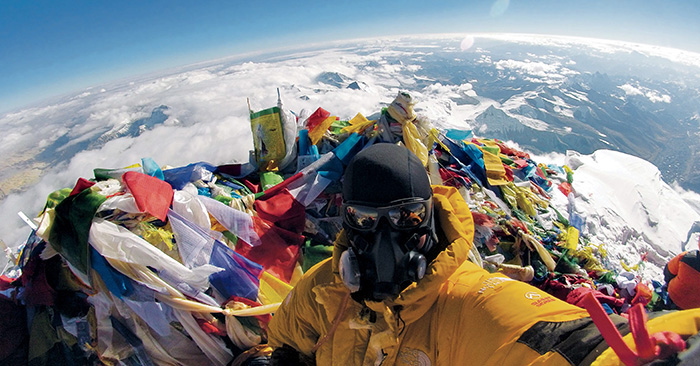
Dean Carriere / Mount Everest ![]() Handheld
Handheld ![]() Photo/.5sec
Photo/.5sec
Everyone has Passions and Interests that ultimately lead to experiences to share and stories to tell. We hope this book inspires you to pursue your own passions in life and to share your stories with the world.
GoPro would not be where it is today without our enthusiastic users who continually capture incredible life experiences and share them with others online. While we’re proud of the content we produce at GoPro, the truth is it’s our users who are GoPro’s most powerful and influential content creators. Just visit GoPro’s Facebook page or Instagram feed: You’ll quickly lose yourself looking at photos and videos from inspired people around the world who participate in every conceivable activity captured from every imaginable angle. GoPro has become an uplifting expression of peoples’ passion for life.
Nick Woodman said it best: “GoPro is helping the world visually communicate in a new and engaging way, and that can only be a good thing.”
GoPro App
The GoPro App allows you to use your smartphone or tablet as a live video remote control. It’s great for framing shots and changing resolutions and frame rates on the fly. Now that GoPros can capture in so many different FOVs and feature so many optional advanced controls, the GoPro App has become an invaluable tool for our media department. The GoPro App streamlines camera setup and shot confirmation leads to overall better content since you can now spend more time experimenting with new shots.
The GoPro App also makes it easy to playback and copy photos and video over Wi-Fi from your GoPro to your smartphone or tablet. This greatly simplifies sharing your favorite moments to Facebook, Instagram, Twitter, and more without needing to wait to connect to a computer. There’s something so fulfilling about immediately sharing an awesome experience with friends and family. Consider sharing photos and short clips of your adventures as teasers for any longer form edits you might want to publish once you get home. The GoPro App also has a feature called HiLight Tag, which allows users to mark key moments inside a video while recording. In addition, the GoPro App links directly to GoPro’s Photo and Video of the Day. These showcase innovative content and can be a great way to generate new ideas for your next project.
In GoPro’s media department, we use the GoPro App most often to preview shots and compose our frame as well as to control the camera remotely. We’ve used it countless times to change FOV or frame rate from a distance after mounting the camera. The camera is often out of reach, so it’s convenient and efficient to have the GoPro App on hand for last-minute tweaks.
Over time, the GoPro App will expand to include editing tools and additional content management features to further simplify the process of capturing, managing, sharing, and enjoying your GoPro content.
GoPro Studio and Edit Templates
GoPro Studio is GoPro’s free desktop editing application. It features a broad range of tools including Flux, a powerful slow motion and speed ramping tool, and Edit Templates, templatized versions of some of GoPro’s best originally produced and user generated content.
Our users frequently ask us how they can learn to edit videos like they see on the GoPro Channel. Edit Templates represent the beginning of our solution, whereby our users can make their favorite GoPro videos their own by replacing our clips with theirs. We’ve already selected the music, set the edit points, and done most of the work to fast-track our users to a great edit.
Our hope is that over time our new users will become more comfortable and courageous with their editing and Edit Templates represent a solid way for them to get started and understand the mechanics of editing. Even for advanced users, Edit Templates make it easy to quickly pull together compelling content to share.
Image Quality and Exporting
Image quality is one of the first things a viewer will notice about your video. Using the proper workflow, you can take GoPro footage from the camera to fully edited video with very little, if any, loss in image quality. You can do a number of things to maintain quality: keep the camera’s firmware updated; use the correct settings during the transcoding, editing, and exporting stages of video creation; and avoid overly aggressive color correction or zooming of footage while editing.
If you’ve worked in an intermediate codec, we recommend compressing your video before uploading it to the web. You can compress the video in your editing program as you export or using third-party software such as Apple Compressor or Sorenson Squeeze. Choosing the right bit rate for video compression is all about compromise. In general, a higher bit rate means a higher quality video. But it also means that the video will take longer to upload and stream. For HD video played over the web, the range of 10 to 30 Mbps (megabits per second) is considered to be a good compromise.
YouTube, Vimeo, and other video services provide upload guidelines with recommended settings. Knowing a little bit about the specifics of compression ensures that your video quality remains high:
![]() Resolution: Use the same resolution as that recommended for the intended playback device. 1920×1080 is a good bet, although YouTube now accepts resolutions as high as 4K.
Resolution: Use the same resolution as that recommended for the intended playback device. 1920×1080 is a good bet, although YouTube now accepts resolutions as high as 4K.
![]() File format: This refers to the container that holds together the video and audio components of a video. For web, this is usually MP4.
File format: This refers to the container that holds together the video and audio components of a video. For web, this is usually MP4.
![]() Video codec: This setting is where you specify the compression on the largest part of your file, the video stream. It is usually set to H.264.
Video codec: This setting is where you specify the compression on the largest part of your file, the video stream. It is usually set to H.264.
![]() Audio codec: You can usually leave this the same as GoPro’s standard audio compression, which is AAC.
Audio codec: You can usually leave this the same as GoPro’s standard audio compression, which is AAC.
![]() Bit rate: This refers to the amount of video information (measured in bits) transferred per second. For HD, always use a variable bit rate centered around 10 to 30 Mbps.
Bit rate: This refers to the amount of video information (measured in bits) transferred per second. For HD, always use a variable bit rate centered around 10 to 30 Mbps.
Uploading video for Instagram requires additional considerations. Instagram video has a square aspect ratio with a resolution of 640 x 640 pixels. We recommend editing on a 1080p timeline (don’t forget the 15 second time limit), and then compressing the video to a bit rate of around 1 to 2 Mbps on export. The file size should be under 10 MB. Email the video to yourself and then use the Instagram app to upload the video. The app will scale your 1080p video to the proper resolution and apply a square crop. Be sure to choose a good crop so that all the essential action is visible.
Forums for Sharing
Online social networks are still a relatively new consumer phenomenon, and it’s no coincidence that GoPro has become a movement of its own during this same period. There would be no Facebook without photos, and no YouTube without videos... and perhaps no GoPro without Facebook, YouTube, and the like. GoPro and online social platforms have developed a symbiotic relationship, each benefiting mutually from the strengths of the other.
In the early days, we were surprised to see our users tag their shared photos and videos with GoPro’s name. Users were so enthusiastic about self-capturing and watching footage of themselves doing what they loved most in life that they developed a strong emotional connection with the product and brand that enabled them to do so. GoPro became less about the product and more about the content and the emotions that the product enabled. GoPro’s ability to connect with its users and fans on an emotional level is a big part of why its brand is so strong.
GoPro shares its content and engages with its users and fans on most relevant social and content distribution platforms, including: YouTube, Vimeo, Instagram, Facebook, Twitter and more.
![]() YouTube: GoPro’s channel has published over 900 videos and has attracted more than 2.4 million subscribers. In 2014, YouTube named GoPro the #1 Brand Channel on its channel leaderboards on account of the viewership and and engaging nature of its content. To date, the channel has garnered over 600 million views.
YouTube: GoPro’s channel has published over 900 videos and has attracted more than 2.4 million subscribers. In 2014, YouTube named GoPro the #1 Brand Channel on its channel leaderboards on account of the viewership and and engaging nature of its content. To date, the channel has garnered over 600 million views.
![]() Instagram: GoPro’s account has over 3.2 million followers with over 1,200 photo and video posts. The feed is considered one of the most engaged brands on the platform. GoPro received a Shorty Award for Best Instagram account in 2014.
Instagram: GoPro’s account has over 3.2 million followers with over 1,200 photo and video posts. The feed is considered one of the most engaged brands on the platform. GoPro received a Shorty Award for Best Instagram account in 2014.
![]() Facebook: GoPro’s page has amassed over 8 million fans. In 2014, GoPro earned an award for Best Facebook Page at the Shorty Awards.
Facebook: GoPro’s page has amassed over 8 million fans. In 2014, GoPro earned an award for Best Facebook Page at the Shorty Awards.
In the following sections, we touch base with individuals who we’ve seen use these platforms to great effect.
YouTube: Abe Kislevitz
In early 2009, Nick Woodman was searching for GoPro customer videos on YouTube and stumbled upon a bunch of GoPro ski videos produced by a USC college student named Abe Kislevitz. Abe’s videos were the first user generated videos that expanded Nick’s mind of what a GoPro was capable of. Nick reached out to Abe through his YouTube account and asked him if he’d like to shoot the launch film for the soon-to-be-released HD HERO. We flew Abe and a couple of his USC Ski Team buddies up to Mt. Hood, Oregon to film “The Ski Movie.” Abe did such a good job that Nick invited him to come work at GoPro after graduation. Fortunately, Abe accepted and now helps lead media production as a Senior Production Artist. Abe also maintains a personal YouTube account that has nearly 40,000 subscribers and 10 million views.
How can YouTube users optimize their subscribers and view counts?
A big part of it is consistently posting videos for a long time. If you have a history of good content, subscribers will look forward to your next project. Another thing is to find a niche, a look and style that is your own, and stay consistent to that. Focus on image quality, content, story...something that’s going to give your videos an edge over everyone else. Lastly, be interactive and engaged with your community, so they feel like you have something to offer every time you release a video. One thing I’ll often do with each video is try a new effect or technique in After Effects. Everyone always asks about it and wants to learn how to do it, so the dialogue around the video becomes interactive.
How can a new GoPro user and content creator get noticed?
At GoPro we always notice the creators who are consistently posting amazing content. I always tell people to stick to it and really hone their skills as an artist, videographer, and editor, and people will pick up on it naturally. That’s how I got noticed and hired. When I’m hiring someone at GoPro, it’s solely based on the portfolio and examples of work because, ultimately, that will tell me if someone is really and truly passionate about what they’re doing. When you find a job that’s truly in line with your passions, you’ll wake up excited to go to work and push yourself every day.
Instagram: Zak Shelhamer
Photographer and former pro snowboarder Zak Shelhamer has been passionate about photography since his dad first introduced him to the household darkroom as a kid. Shelhamer and his friend Eric Willett were featured in GoPro’s first “Snowboard Movie.” Since then, he has seen his passions for adventure and photography come together in a lead production artist position at GoPro, and on Instagram, where he has more than 170,000 followers.
What is photography to you?
Being a photographer isn’t about knowing how to set up lights, or knowing what an f-stop is. These are tools, sure. But I believe photography is all about creating emotion through a picture.
What’s your strategy for Instagram?
First, post your photos at noon, Pacific Standard Time. That way you get the people at lunch break on the West Coast, people just getting off work on the East Coast, and anyone who isn’t in bed yet in Europe. Second, post consistently. Post along a schedule so people can expect to see new content from you regularly. Third, engage with your followers by commenting on their photos and answering any questions. As far as workflow, I use the GoPro App to send the photo to my phone. Then I’ll use Snapseed to do a basic color pass before bringing it into Instagram. I used to take a lot more photos with my iPhone or DSLR, but these days 95% of my Instagrams are GoPro.
What is the best part about Instagram and why is it important in your life?
When you join Instagram, your first followers will be your immediate circle of close friends. Once that circle grows as people beyond your friends recognize your hard work, it’s really gratifying. When Instagram was first taking off several years ago, I was contacted by them because they liked my photos. I got featured on Instagram’s suggested user page and I suddenly jumped from a couple hundred followers to 50,000 followers in a few months. I was getting thousands of likes and comments from people I didn’t know, which was validating. So that’s the first stage, recognition, but then comes the pressure. You’ve earned followers’ attention and trust and you don’t want to disappoint them. The good thing is that 99% of the recognition, likes, and comments are positive. Listen to that feedback, translate it, and weave it into your work. It’s crucial for growing as an artist.
Facebook: GoPro Bomb Squad
In the summer of 2010, Neil Amonson and Marshall Miller were in Switzerland capturing their BASE jumps with a couple of GoPros and dreaming about doing exactly that for the rest of their lives. Thus, the GoPro Bomb Squad was born. They later picked up two other members, Jesse Hall and JT Holmes. Today, the four travel the world BASE jumping, skydiving, speedflying, paragliding, and wingsuit flying. The GoPro Bomb Squad’s Facebook page has been a pivotal tool in the group’s development and their profession.
Describe the growth of your Facebook page.
Our first 100 fans were all our friends, when we started the page. But soon, we jumped to 1,000 fans when we posted from the Teva Mountain Games in Vail, Colorado. When you’re at 100 you can’t even imagine having 1,000 fans. Every time GoPro shared one of our photos, we’d jump another thousand. So half a year later we had 90,000 fans. Now we’re nearing 150,000.
What’s your strategy for Facebook posts?
Being good at social media is much harder than people think. You have to generate a lot of content, and you have to keep up with it, over and over and over. You can’t just put a cool picture up and then not do anything for a month. In the beginning, we tried to do one post a week. Now we try to post once every day, or at least three to four times a week. We try to be approachable and interactive. But most importantly, we have a high quality standard. We do a ton of jumps, but if we don’t feel like we’ve captured “the moment,” then we don’t share it. Every jump, we’re very mindful of where the camera is and what it’s capturing. Bottom line: You have to be creative on the shots, and make them new and fresh.
How does Facebook fit into your group as a business?
Our business as the GoPro Bomb Squad is so socially based it makes us feel a little vulnerable, but it’s probably not going anywhere. GoPro was our first sponsor and our title sponsor, then we picked up ten other sponsors largely because of GoPro’s backing and our presence on social networks like Facebook. When production companies or TV shows are hiring, they quickly go to our Facebook page—it gives us such credibility as a business.
Viral Videos
A video that goes viral quickly gains a huge number of views and shares. When content is so newsworthy, exciting, or meaningful to a massive number of people, they cannot help but share it with everyone they know—whether online or in everyday life. Ad agencies try to duplicate it. PR machines try to induce it. But true virality is not an exact science. You know a viral video when you see it, but it’s nearly impossible to conjure one out of thin air. At GoPro, a number of our videos have gone viral, from Mike Montgomery’s uncut slopestyle run in the early days to the more recent and meteoric “Fireman Saves Kitten.”
Some subjects naturally attract big audiences on YouTube and tend to be shared often. For some inexplicable reason, cats are often at the top of this list. After you watch “Fireman Saves Kitten,” take a moment to view the original video (“The Rescue” by fireman Cory Kalanick, which is linked in the online description). This is the original video that GoPro production artist Tyler Johnson found one day. At over 500,000 views, the original video had done pretty well at the time, so Tyler decided to try to acquire the content for the GoPro channel. From the original video, it wasn’t immediately apparent that a quality moment could be crafted from the footage.
Once the raw video arrived, Tyler spent the better part of several weeks really crafting the story—selecting the best shots, sound designing the breathing and sirens for the intro, recording radio voiceover, and selecting music. The content was there, but he needed to bring out the story in editing to make it really shine. The result is a short and sweet little story that is emotional, meaningful, and extremely shareable for a wide audience...as evident from the 24 million views it has received since.
Videos don’t have to be short to be viral or shareable. We believe the main reason most viral videos tend to be short is because longer, more engaging videos are so much more difficult to create. The longer a video is, the more difficult it becomes to maintain audience attention through careful structuring of story. Viewers quickly start to tune out if they are not receiving new information, or if the video lacks a larger structure. However, a well-structured and well-paced video creates an immersive experience in which the casual viewer—the one who only planned to watch a 30-second Internet video—may end up sticking around for 5, 10, 15 minutes, or longer.
Another one of GoPro’s most viral videos is also about cats, but this one is nearly 15 minutes long. “Lions - The New Endangered Species?” made everyone at GoPro realize the true value of great storytelling. The edit took months to cut, and during that time some folks at GoPro headquarters suggested chopping the video into three episodes. They feared that nobody would stick around for 15 minutes to watch an entire short film on YouTube. But we insisted, and so the piece stayed whole.
Before releasing the 15-minute story, we released the 60-second “Lion Hug” clip a couple of months before. The clip gave the audience the most sensational footage of Kevin Richardson and his lions in the span of one minute. This short video did well, quickly rising to 2.5 million views in the first few weeks before plateauing. When we finally released our 15-minute lion story, it didn’t perform as well in the first month. But then it kept growing. And growing. And growing. Over the next six months, the 15-minute long “Lions - The New Endangered Species?” started to eclipse even our product launch videos. Viewership is still growing at 22 million views, while “Lion Hug” is hovering at 3.5 million.
This case study of the “Lion Hug” and “Lions - The New Endangered Species?” really shows that virality is about unique content and great storytelling. If a filmmaker can combine both, the potential for views and shares increases exponentially.
Think of the largest gathering you’ve ever been to—maybe a stadium concert or sporting event. Think of the 50,000 people concentrated in one place. You can feel the energy. It’s electric, maybe overwhelming. So many people doing or watching the same thing and feeding off that energy. You step back and think, “Wow, this is what 50,000 people feel like.”
Now, take that gathering and double it. Triple it. Multiply it by 400. What would it feel like if 20,000,000 people all watched your video? Because that’s exactly what can—and does—happen. That’s the power that we as individuals have in this modern age.
So, then the question becomes:
What story are you going to tell them?






